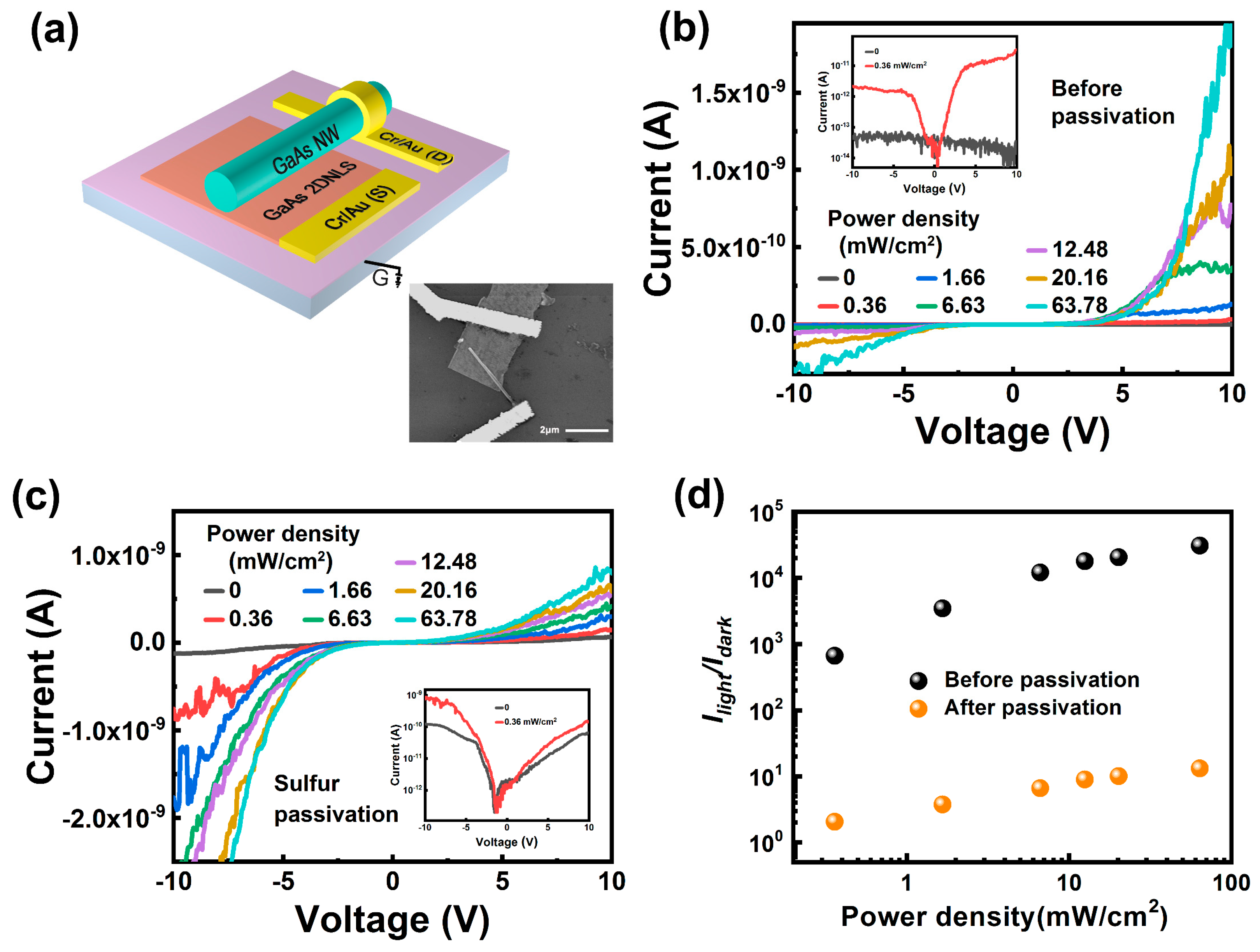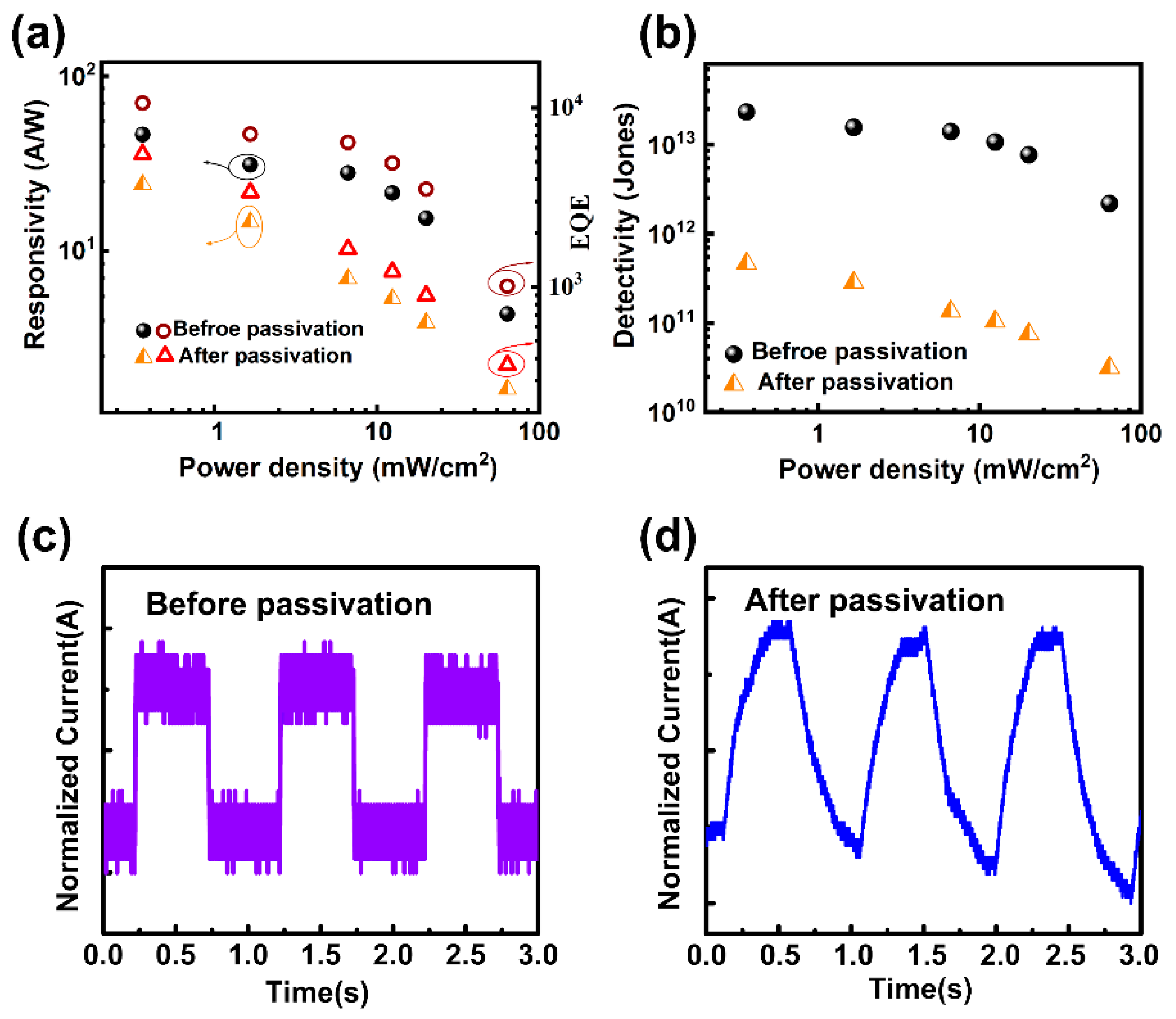Fast Response GaAs Photodetector Based on Constructing Electron Transmission Channel
Abstract
:1. Introduction
2. Materials and Methods
2.1. Preparation of GaAs NW and GaAs 2DNLS
2.2. Fabrication of GaAs Photodetectors
2.3. Materials and Devices Characterization
3. Results
4. Conclusions
Supplementary Materials
Author Contributions
Funding
Conflicts of Interest
References
- Luo, Y.; Yan, X.; Zhang, X.; Zhang, M.; Ren, X. Enhanced performance of graphene/GaAs nanowire photoelectric conversion devices by improving the Schottky barrier height. J. Vac. Sci. Technol. B 2019, 37, 051202. [Google Scholar] [CrossRef]
- Xu, X.; Wang, H. Resonant energy transfer between patterned InGaN/GaN quantum wells and CdSe/ZnS quantum dots. Nanoscale 2016, 8, 342–347. [Google Scholar] [CrossRef]
- Luo, T.; Lian, B.; Liu, Z.; Xie, X.; Lou, Z.; Shen, G. Single-GaSb-nanowire-based room temperature photodetectors with broad spectral response. Sci. Bull. 2015, 60, 101–108. [Google Scholar] [CrossRef] [Green Version]
- Michel, J.; Liu, J.; Kimerling, L.C. High-performance Ge-on-Si photodetectors. Nat. Photonics 2010, 4, 527–534. [Google Scholar] [CrossRef]
- Zheng, D.; Wang, J.; Hu, W.; Liao, L.; Fang, H.; Guo, N.; Wang, P.; Gong, F.; Wang, X.; Fan, Z.; et al. When Nanowires Meet Ultrahigh Ferroelectric Field-High-Performance Full-Depleted Nanowire Photodetectors. Nano Lett. 2016, 16, 2548–2555. [Google Scholar] [CrossRef]
- Sun, L.; Wang, C.; Xu, L.; Wang, J.; Liu, X.; Chen, X.; Yi, G.C. SbSI whisker/PbI2 flake mixed-dimensional van der Waals heterostructure for photodetection. Cryst. Eng. Comm. 2019, 21, 3779–3787. [Google Scholar] [CrossRef]
- Lee, Y.T.; Jeon, P.J.; Han, J.H.; Ahn, J.; Lee, H.S.; Lim, J.Y.; Choi, W.K.; Song, J.D.; Park, M.C.; Im, S.; et al. Mixed-Dimensional 1D ZnO-2D WSe2 van der Waals Heterojunction Device for Photosensors. Adv. Funct. Mater. 2017, 27, 1703822. [Google Scholar] [CrossRef]
- Liao, L.; Lin, Y.C.; Bao, M.; Cheng, R.; Bai, J.; Liu, Y.; Qu, Y.; Wang, K.L.; Huang, Y.; Duan, X. High-speed graphene transistors with a self-aligned nanowire gate. Nature 2010, 467, 305–308. [Google Scholar] [CrossRef]
- Wang, D.; Chen, X.; Fang, X.; Tang, J.; Lin, F.; Wang, X.; Liu, G.; Liao, L.; Ho, J.C.; Wei, Z. Photoresponse improvement of mixed-dimensional 1D-2D GaAs photodetectors by incorporating constructive interface states. Nanoscale 2021, 13, 1086–1092. [Google Scholar] [CrossRef] [PubMed]
- Boland, J.L.; Casadei, A.; Tutuncuoglu, G.; Matteini, F.; Davies, C.L.; Jabeen, F.; Joyce, H.J.; Herz, L.M.; Fontcuberta, M.A.; Johnston, M.B. Increased Photoconductivity Lifetime in GaAs Nanowires by Controlled n-Type and p-Type Doping. ACS Nano 2016, 10, 4219–4227. [Google Scholar] [CrossRef] [Green Version]
- Luo, L.B.; Chen, J.J.; Wang, M.Z.; Hu, H.; Wu, C.Y.; Li, Q.; Wang, L.; Huang, J.A.; Liang, F.X. Near-Infrared Light Photovoltaic Detector Based on GaAs Nanocone Array/Monolayer Graphene Schottky Junction. Adv. Funct. Mater. 2014, 24, 2794–2800. [Google Scholar] [CrossRef]
- Shen, L.; Pun, E.Y.B.; Ho, J.C. Recent developments in III–V semiconducting nanowires for high-performance photodetectors. Mater. Chem. Front. 2017, 1, 630–645. [Google Scholar] [CrossRef]
- Chang, C.C.; Chi, C.Y.; Yao, M.; Huang, N.; Chen, C.C.; Theiss, J.; Bushmaker, A.W.; Lalumondiere, S.; Yeh, T.W.; Povinelli, M.L.; et al. Electrical and optical characterization of surface passivation in GaAs nanowires. Nano Lett. 2012, 12, 4484–4489. [Google Scholar] [CrossRef] [PubMed]
- Chen, X.; Xia, N.; Yang, Z.; Gong, F.; Wei, Z.; Wang, D.; Tang, J.; Fang, X.; Fang, D.; Liao, L. Analysis of the influence and mechanism of sulfur passivation on the dark current of a single GaAs nanowire photodetector. Nanotechnology 2018, 29, 095201. [Google Scholar] [CrossRef]
- Wang, Z.L.; Hao, Z.B.; Yu, J.D.; Wu, C.; Wang, L.; Wang, J.; Sun, C.Z.; Xiong, B.; Han, Y.J.; Li, H.T.; et al. Manipulating the Band Bending of InGaN/GaN Quantum Dots in Nanowires by Surface Passivation. J. Phys. Chem. C. 2017, 121, 6380–6385. [Google Scholar] [CrossRef]
- van Tilburg, J.W.W.; Algra, R.E.; Immink, W.G.G.; Verheijen, M.; Bakkers, E.P.A.M.; Kouwenhoven, L.P. Surface passivated InAs/InP core/shell nanowires. Semicond. Sci. Technol. 2010, 25, 024011. [Google Scholar] [CrossRef] [Green Version]
- Lee, H.Y.; Lu, D.E.; Lee, C.T. Performance improvement of GaN-based ultraviolet metal–semiconductor–metal photodetectors using chlorination surface treatment. J. Vac. Sci. Technol. B Microelectron. Nanometer. Struct. 2012, 30, 031211. [Google Scholar] [CrossRef]
- Kang, Y.; Tang, J.L.; Wang, P.; Lin, F.; Fang, X.; Fang, D.; Wang, D.; Wang, X.; Wei, Z. High density GaAs nanowire arrays through substrate processing engineering. Mater. Res. Express 2018, 6, 035012. [Google Scholar] [CrossRef]
- Tao, P.; Yao, S.; Liu, F.; Wang, B.; Huang, F.; Wang, M. Recent advances in exfoliation techniques of layered and non-layered materials for energy conversion and storage. J. Mater. Chem. A 2019, 7, 23512–23536. [Google Scholar] [CrossRef]
- Yoon, J.; Jo, S.; Chun, I.S.; Jung, I.; Kim, H.S.; Meitl, M.; Menard, E.; Li, X.; Coleman, J.J.; Paik, U.; et al. GaAs photovoltaics and optoelectronics using releasable multilayer epitaxial assemblies. Nature 2010, 465, 329–333. [Google Scholar] [CrossRef] [PubMed]
- Soci, C.; Zhang, A.; Xiang, B.; Dayeh, S.A.; Aplin, D.P.R.; Park, J.; Bao, X.Y.; Lo, Y.H.; Wang, D. ZnO nanowire UV photodetectors with high internal gain. Nano Lett. 2007, 7, 1003–1009. [Google Scholar] [CrossRef]
- Gong, M.G.; Kirkeminde, A.; Xie, Y.; Lu, R.T.; Liu, J.W.; Wu, J.Z.; Ren, S.Q. Iron pyrite (FeS2) broad spectral and magnetically responsive photodetectors. Adv. Opt. Mater. 2013, 1, 78–83. [Google Scholar] [CrossRef]
- Wei, H.T.; Fang, Y.J.; Yuan, Y.B.; Shen, L.; Huang, J.S. Trap engineering of CdTe nanoparticle for high gain, fast response, and low noise P3HT:CdTe nanocomposite photodetectors. Adv. Mater. 2015, 27, 4975–4981. [Google Scholar] [CrossRef]
- Wu, Y.; Yan, X.; Zhang, X.; Ren, X. A monolayer graphene/GaAs nanowire array Schottky junction self-powered photodetector. Appl. Phys. Lett. 2016, 109, 183101. [Google Scholar] [CrossRef]
- Ali, H.; Zhang, Y.Y.; Tang, J.; Peng, K.; Sun, S.B.; Sun, Y.; Song, F.L.; Falak, A.; Wu, S.Y.; Qian, C.J.; et al. High-responsivity photodetection by a self-catalyzed phase-pure p-GaAs nanowire. Small 2018, 14, 1704429. [Google Scholar]
- Zhu, X.; Lin, F.; Zhang, Z.; Chen, X.; Huang, H.; Wang, D.; Tang, J.; Fang, X.; Fang, D.; Ho, J.C.; et al. Enhancing Performance of a GaAs/AlGaAs/GaAs Nanowire Photodetector Based on the Two-Dimensional Electron-Hole Tube Structure. Nano Lett. 2020, 20, 2654–2659. [Google Scholar] [CrossRef] [PubMed]
- Chen, X.; Jiang, B.; Wang, D.; Li, G.; Wei, Z. Gate-tunable the interface properties of GaAs–WSe2 (1D–2D) vdWs heterojunction for high-responsivity, self-powered photodetector. Appl. Phys. Lett. 2021, 118, 041102. [Google Scholar] [CrossRef]
- Milines, A.G.; Feucht, D.L. Heterojunction and Metal-Semiconductor Junction; Academic Press: New York, NY, USA, 1972. [Google Scholar]
- Bera, A.; Basak, D. Carrier relaxation through two-electron process during photoconduction in highly UV sensitive quasi-one-dimensional ZnO nanowires. Appl. Phys. Lett. 2008, 93, 053102. [Google Scholar] [CrossRef]
- Liu, H.Y.; Hsu, W.C.; Chou, B.Y.; Wang, Y.H. A Simple Passivation Technique for AlGaN/GaN Ultraviolet Schottky Barrier Photodetector. IEEE Photonics Technol. Lett. 2014, 26, 138–141. [Google Scholar] [CrossRef]





| Material | R (mA/W) | τr/τd (ms) | Reference |
|---|---|---|---|
| GaAs NW | 1.82 × 104 | -/188 | [14] |
| Passivated GaAs NW | 2.5 × 104 | -/269 | [14] |
| Pure-phase GaAs NW | 1.45 × 108 | - | [25] |
| GaAs/AlGaAs/GaAs NW | 570 | 175/190 | [26] |
| GaAs NW/WSe2 | 511 | 246/280 | [27] |
| Graphene/GaAs NW | 301 | 0.042/0.14 | [1] |
| GaAs NW/GaAs 2DNLS | 4.63 × 104 | 4.7/6.1 | this work |
Publisher’s Note: MDPI stays neutral with regard to jurisdictional claims in published maps and institutional affiliations. |
© 2021 by the authors. Licensee MDPI, Basel, Switzerland. This article is an open access article distributed under the terms and conditions of the Creative Commons Attribution (CC BY) license (https://creativecommons.org/licenses/by/4.0/).
Share and Cite
Guo, S.; Chen, X.; Wang, D.; Fang, X.; Fang, D.; Tang, J.; Liao, L.; Wei, Z. Fast Response GaAs Photodetector Based on Constructing Electron Transmission Channel. Crystals 2021, 11, 1160. https://doi.org/10.3390/cryst11101160
Guo S, Chen X, Wang D, Fang X, Fang D, Tang J, Liao L, Wei Z. Fast Response GaAs Photodetector Based on Constructing Electron Transmission Channel. Crystals. 2021; 11(10):1160. https://doi.org/10.3390/cryst11101160
Chicago/Turabian StyleGuo, Shuai, Xue Chen, Dengkui Wang, Xuan Fang, Dan Fang, Jilong Tang, Lei Liao, and Zhipeng Wei. 2021. "Fast Response GaAs Photodetector Based on Constructing Electron Transmission Channel" Crystals 11, no. 10: 1160. https://doi.org/10.3390/cryst11101160
APA StyleGuo, S., Chen, X., Wang, D., Fang, X., Fang, D., Tang, J., Liao, L., & Wei, Z. (2021). Fast Response GaAs Photodetector Based on Constructing Electron Transmission Channel. Crystals, 11(10), 1160. https://doi.org/10.3390/cryst11101160





